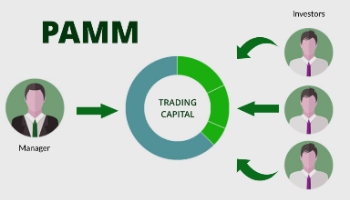Forex PAMM accounts are based on an investment concept that has been around for a long time. Asset management companies such as hedge funds and trust funds are known to pool funds from numerous investors to invest in different assets in the capital markets. Forex PAMM accounts adopt a similar concept, where funds from different investors are pooled together to be managed by a professional FX trader.
Nowadays, PAMM Forex accounts are gaining popularity for a multitude of reasons. We will provide you with all the information on what is PAMM account in Forex, the best Forex brokers offering PAMM accounts, PAMM Forex trading options for traders and investors, and how to open a PAMM Forex account at a broker with the best-managed account platform.
Best Forex Brokers for PAMM Account
| Broker | Deposit* | Leverage* | Platforms | Assets | Regulation | Visit |
|---|---|---|---|---|---|---|
| XM | Min. Deposit: $5 | Max. Leverage: 1:1000 |
Trading Platforms:
|
Assets:
|
Regulation:
|
Visit XM XM review |
| XTB | Min. Deposit: - | Max. Leverage: 1:500 |
Trading Platforms:
|
Assets:
|
Regulation:
|
Visit XTB XTB review |
| Eightcap | Min. Deposit: $100 | Max. Leverage: 1:500 |
Trading Platforms:
|
Assets:
|
Regulation:
|
Visit Eightcap Coming soon |
| AvaTrade | Min. Deposit: $200 | Max. Leverage: 1:400 |
Trading Platforms:
|
Assets:
|
Regulation:
|
Visit AvaTrade AvaTrade review |
| Pepperstone | Min. Deposit: $200 | Max. Leverage: 1:500 |
Trading Platforms:
|
Assets:
|
Regulation:
|
Visit Pepperstone 74-89% of retail investor accounts lose money Pepperstone review |
| Bubinga | Min. Deposit: $5 | Max. Leverage: - |
Trading Platforms:
|
Assets:
|
Regulation:
|
Visit Bubinga Coming soon |
What Is PAMM Account in Forex?
PAMM is an acronym that stands for a “percentage allocation management module”, but it is also informally known as “percentage allocation money management.” The concept of PAMM Forex trading is simple. Investors deposit their money into a pooled fund, which is managed by a master Forex trader, also known as an account manager or fund manager. The master trader then uses this entire fund to trade the markets, where the profits or losses are reflected on the final account equity.
These managed accounts are perfect for investors who don’t have the time, expertise, or risk appetite for trading the market themselves as they can entrust their funds with a professional trader to trade the markets on their behalf. In exchange, they have to pay a performance fee to the master trader, which can be a portion of the profits or a fixed performance fee.
Master traders, on the other hand, can use their trading skills and expertise to earn additional revenue, which can be a percentage profit share or fixed fee revenue. PAMM Forex trading is facilitated through a dedicated add-on plugin connected to an existing trading platform, which acts as a bridge between traders and investors.
How Do Forex PAMM Account Brokers Split the Profits and Losses?

Managed accounts have a slightly different pricing model from that of conventional Forex trading accounts. The profits and losses accrued in a PAMM account are split according to each investor’s contribution to the overall fund. Let us illustrate an example to explain what is PAMM account in Forex and how it works. Let’s assume that there is a master trader who is offering managed account services through their Forex PAMM account. Let us also assume that there are 3 investors (this is just a hypothetical scenario since the number of investors can be much higher, while the trader remains independent) looking to invest their funds.
The master trader has to pitch in the seed capital to initiate the fund, which, for this example, shall be set at $50,000. The 3 investors can then add money to the pool, which, for this purpose, shall be $25,000, $10,000, and $15,000. Therefore, the total amount of money in the pooled fund is $100,000.
As a result, the master trader holds a 50% contribution to the fund, while the remaining 3 investors contribute 25%, 10%, and 15%, respectively. Thus, once the master trader commences their trading activity, the profits are added to the main fund minus any performance fee or percentage profit share. However, in the event of a loss, this losing amount is deducted from the fund, but there are no performance fees or percentage shares charged by the master trader.
Since Forex and CFD trading involves a high degree of risk, master traders and investors enter into a limited partnership and sign a trading agreement that acknowledges the risks of loss and account equity drawdowns. Under the rules of Forex PAMM accounts, investors assign a limited power of attorney to traders to manage their funds. Therefore, the profits are split according to the individual contributions of each investor minus any profit share or performance fee as applicable. Investors are free to withdraw a part of or their entire investment, but this will result in a proportionate drop in the contribution from profits accrued by the fund.
The entire process of PAMM Forex trading, investor account funding, splitting profits, and all other calculations are done automatically by the PAMM platform.
Opening a PAMM Forex Account?

Forex brokers offering PAMM accounts usually have standalone money management accounts that are kept separate from their conventional Forex trading accounts. Both master traders and investors are given the option to open a trader account or an investment account through the broker’s website and are subsequently granted access to their respective platforms through the broker’s account management dashboard. Forex PAMM account brokers follow the same rules and regulations for all of their clients, which means that both account managers and investors may be required to verify their identities at the time of account registration.
However, the entire percentage money allocation and investor funding process is done only after an extensive account vetting process. Forex brokers offering PAMM accounts first subject master traders to an extensive performance evaluation program to ensure that they have the necessary skills, knowledge, certifications, and licenses to manage and trade funds on investors’ behalf.
Each fund manager has to be approved by the broker’s internal committee, which scrutinizes trader activity, strategies, emotional prowess, psychological strengths, and long-term performance under live market conditions. Traders have to trade the markets with real accounts. They should demonstrate a clear and concise capability to manage risk, avoid amateur errors, and attain consistent profits to be approved as master traders.
On the other hand, investors are not subject to any vetting process. They can open a PAMM Forex account and start investing their money into a pooled account as soon as they register an account and deposit funds. They have complete freedom over the choice of master traders and are free to choose any number of investment accounts as they please.
Some of the best Forex brokers for PAMM account offer several unique benefits, which include the ability to split the investment into multiple master trade accounts, withdraw funds partially, and discover the top-performing master traders through advanced trader analytics. A few of our recommended Forex PAMM account brokers even combine modern social trading concepts with the traditional managed account model so that you can get the best of both worlds.
Should Traders Opt for Managed Accounts over Self-Traded Accounts?
Investors and traders have varying skills, knowledge, experience, expectations, risk appetites, and abilities to trade, so it is not easy to recommend the best option for a particular individual. However, we have compiled a few of the advantages and concerns of PAMM Forex trading so that you can make an informed choice before you open a PAMM Forex account.
- Investors don’t have to make any trading decisions, which eliminates the stress of trading.
- Master traders have full freedom over their trading strategies as investors can withdraw funds at any time if they are not satisfied with an account manager’s strategies or performance.
- Investors only pay performance fees or a percentage share for profitable trades, while no fees are incurred for losing trades.
- Fund managers get access to increased capital, which increases their exposure to the market for higher returns.
- Investors don’t need to possess technical knowledge, skills, or trading expertise.
- Account managers can be guaranteed a share in the profits since Forex PAMM account brokers have advanced automated account management tools to ensure on-time and accurate payments.
- Investors have no say in the trading strategies, and if they are not pleased with an account manager’s performance or trading strategies, they can only withdraw their money from the PAMM master account.
- Investors may lose more money if they do not choose a trusted master trader.
- PAMM Forex trading account managers cannot control who invests in their funds.
- The trading fees can be quite high so as to compensate the broker for their services and the PAMM platform.
Other Similar Services — LAMM, RAMM, and MAM
PAMM is just 1 type of managed account, with LAMM, RAMM, and MAM being some of the less popular ones in the market. LAMM stands for “lot allocation management module”, where trading activities and investments are copied from a money manager instead of money being added into a pooled fund. Hence, LAMM managers do not manage external funds but are compensated every time a copier copies or follows their trade.
RAMM is nothing but another form of PAMM, standing for “risk allocation management module”. Here, instead of percentage allocation, the investor considers the risk aspect per trade or the risk assumed during a trading period. The funds are deposited into a single pool, but trades and profits/losses are based on the investor’s risk appetite.
Finally, MAM is the abbreviation of “multi-account management”, an account management system where funds are not pooled into a single fund. Instead, a single fund manager manages multiple trading accounts, with each account contributing a percentage of the equity set by the investor. Ultimately, the investor has more control over their accounts and can manage their trades, thereby rendering more flexibility in managing risk.
Do the Best Forex Brokers for PAMM Account Deliver the Results?
Forex trading is highly volatile and incredibly risky. Hence, nobody can guarantee profitability since even the best FX traders face sustained drawdowns and hefty losses. However, it all depends on how well traders manage their financial and emotional risks, which determines their long-term profitability. Therefore, PAMM Forex trading is not always guaranteed to deliver positive results. Still, if you are proactive in choosing the best master traders, you can expect consistent results without major hassles.
It is also imperative to evaluate the strategies and performance of all fund managers before you open a PAMM Forex account. Past performance does not guarantee future results but will likely dictate future performance. On the other hand, PAMM and other types of fund management systems are excellent tools for professional traders to reach new audiences, increase market exposure, and achieve higher returns. They are also guaranteed to bring in a consistent stream of revenue. Therefore, managed systems such as PAMM are very useful in Forex trading.
